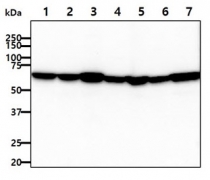ARG57162
anti-AIF antibody [22E9]
anti-AIF antibody [22E9] for ICC/IF,Western blot and Human
Overview
| Product Description | Mouse Monoclonal antibody [22E9] recognizes AIF |
|---|---|
| Tested Reactivity | Hu |
| Tested Application | ICC/IF, WB |
| Host | Mouse |
| Clonality | Monoclonal |
| Clone | 22E9 |
| Isotype | IgG2a, kappa |
| Target Name | AIF |
| Antigen Species | Human |
| Immunogen | Recombinant fragment around aa. 98-609 of Human AIF |
| Conjugation | Un-conjugated |
| Alternate Names | CMTX4; NAMSD; COWCK; Apoptosis-inducing factor 1, mitochondrial; CMT2D; EC 1.1.1.-; NADMR; PDCD8; COXPD6; AIF; Programmed cell death protein 8 |
Application Instructions
| Application Suggestion |
|
||||||
|---|---|---|---|---|---|---|---|
| Application Note | * The dilutions indicate recommended starting dilutions and the optimal dilutions or concentrations should be determined by the scientist. |
Properties
| Form | Liquid |
|---|---|
| Purification | Purification with Protein A. |
| Buffer | PBS (pH 7.4), 0.02% Sodium azide and 10% Glycerol. |
| Preservative | 0.02% Sodium azide |
| Stabilizer | 10% Glycerol |
| Concentration | 1 mg/ml |
| Storage Instruction | For continuous use, store undiluted antibody at 2-8°C for up to a week. For long-term storage, aliquot and store at -20°C. Storage in frost free freezers is not recommended. Avoid repeated freeze/thaw cycles. Suggest spin the vial prior to opening. The antibody solution should be gently mixed before use. |
| Note | For laboratory research only, not for drug, diagnostic or other use. |
Bioinformation
| Database Links |
Swiss-port # O95831 Human Apoptosis-inducing factor 1, mitochondrial |
|---|---|
| Gene Symbol | AIFM1 |
| Gene Full Name | apoptosis-inducing factor, mitochondrion-associated, 1 |
| Background | This gene encodes a flavoprotein essential for nuclear disassembly in apoptotic cells, and it is found in the mitochondrial intermembrane space in healthy cells. Induction of apoptosis results in the translocation of this protein to the nucleus where it affects chromosome condensation and fragmentation. In addition, this gene product induces mitochondria to release the apoptogenic proteins cytochrome c and caspase-9. Mutations in this gene cause combined oxidative phosphorylation deficiency 6 (COXPD6), a severe mitochondrial encephalomyopathy, as well as Cowchock syndrome, also known as X-linked recessive Charcot-Marie-Tooth disease-4 (CMTX-4), a disorder resulting in neuropathy, and axonal and motor-sensory defects with deafness and mental retardation. Alternative splicing results in multiple transcript variants. A related pseudogene has been identified on chromosome 10. [provided by RefSeq, Aug 2015] |
| Function | Functions both as NADH oxidoreductase and as regulator of apoptosis. In response to apoptotic stimuli, it is released from the mitochondrion intermembrane space into the cytosol and to the nucleus, where it functions as a proapoptotic factor in a caspase-independent pathway. In contrast, functions as an antiapoptotic factor in normal mitochondria via its NADH oxidoreductase activity. The soluble form (AIFsol) found in the nucleus induces 'parthanatos' i.e. caspase-independent fragmentation of chromosomal DNA. Interacts with EIF3G,and thereby inhibits the EIF3 machinery and protein synthesis, and activates casapse-7 to amplify apoptosis. Plays a critical role in caspase-independent, pyknotic cell death in hydrogen peroxide-exposed cells. Binds to DNA in a sequence-independent manner. [UniProt] |
| Calculated MW | 67 kDa |
| PTM | Under normal conditions, a 54-residue N-terminal segment is first proteolytically removed during or just after translocation into the mitochondrial intermembrane space (IMS) by the mitochondrial processing peptidase (MPP) to form the inner-membrane-anchored mature form (AIFmit). During apoptosis, it is further proteolytically processed at amino-acid position 101 leading to the generation of the mature form, which is confined to the mitochondrial IMS in a soluble form (AIFsol). AIFsol is released to the cytoplasm in response to specific death signals, and translocated to the nucleus, where it induces nuclear apoptosis in a caspase-independent manner. Ubiquitination by XIAP/BIRC4 does not lead to proteasomal degradation. Ubiquitination at Lys-255 by XIAP/BIRC4 blocks its ability to bind DNA and induce chromatin degradation, thereby inhibiting its ability to induce cell death. |
Images (3) Click the Picture to Zoom In
-
ARG57162 anti-AIF antibody [22E9] ICC/IF image
Immunofluorescence: Hep3B cells line stained with ARG57162 anti-AIF antibody [22E9] at 1:100 (Green).
DAPI (Blue) for nucleus staining.
-
ARG57162 anti-AIF antibody [22E9] WB image
Western blot: 40 µg of 1) Jurkat, 2) HeLa, 3) Hep3B, 4) Raji, 5) K562, 6) MCF7, and 7) CTLL2 cell lysates stained with ARG57162 anti-AIF antibody [22E9] at 1:1000.
-
ARG57162 anti-AIF antibody [22E9] WB image
Western blot: 40 µg of 1) Mouse heart, and 2) Mouse liver tissue lysates stained with ARG57162 anti-AIF antibody [22E9] at 1:1000.








